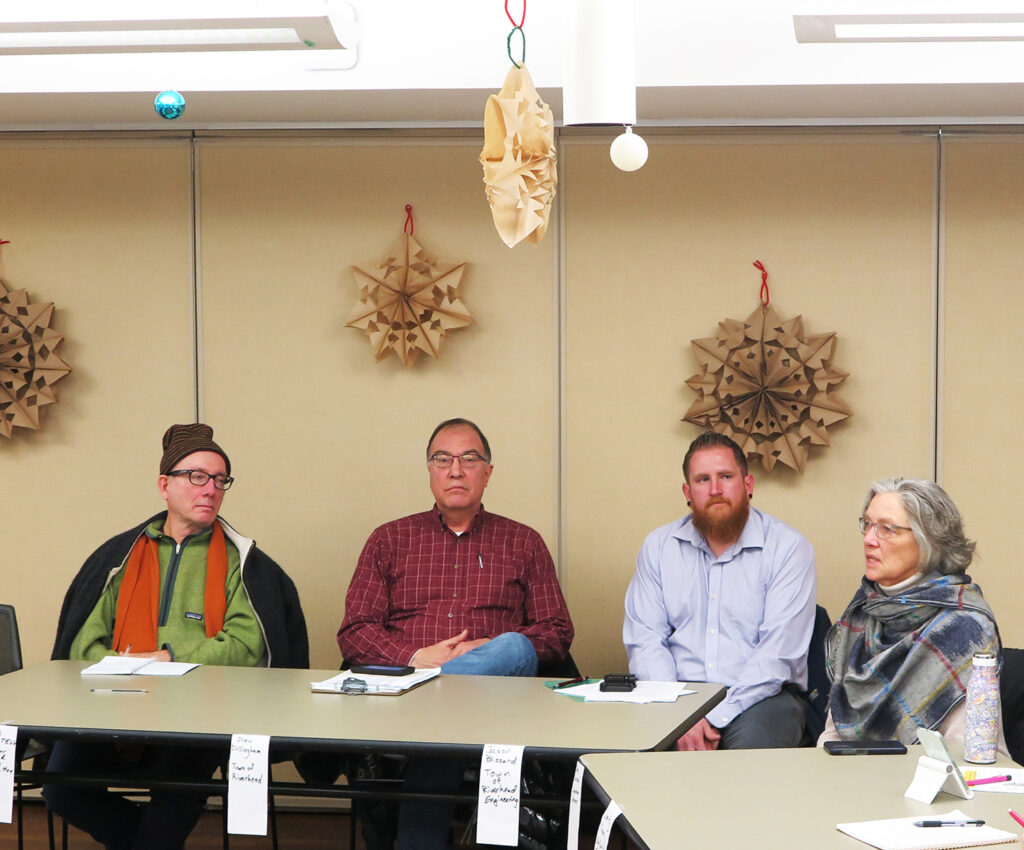Talking turkey: Number of Island birds on the rise

One bird slowly strutted around the sheep pen at Sylvester Manor on a drizzly morning last week.
Another sat trying to bury its long neck deeper into its feathers. The only other resident of the pen was an ill-tempered and very vocal ram, pacing, out of sorts because he had been segregated from the ewes.
“Those two are the slow ones,” Gunnar Wissemann, the Manor’s caretaker said, pointing at the turkeys from the driver’s seat of his pickup. He meant slow in wit, not speed.
The 20 to 70 birds that roam Sylvester Manor like to roost in pine trees, which surround the sheep pen, and then drop down to pick at what they can find for breakfast. “Then they all fly over the fence in the morning, but these two take awhile to remember how to do it,” Mr. Wissemann said. “The others wait for them for awhile but then they leave.”
One of the daily rounds of the Manor’s flock is the 4-poster unit, baited with corn, placed to put a tickicide on the necks of deer as they feed, but also providing a nice fast-food stop for the birds.
If you’ve had the impression there are more birds around, taking their time haughtily stepping across roads, or hanging out in parking lots or on lawns, you’re right. The eastern wild turkey, or to give them their Latin due, meleagris gallopavo silvestri, has been increasing in number on Shelter Island over the last several years, according to Mashomack Preserve Director Mike Laspia. “And they’re dispersing farther around the Island,” Mr. Laspia added.
He noted that the turkeys have been spotted gobbling in Silver Beach, which is relatively new digs for them, and there’s been a noticeable increase of turkeys in Mashomack. “We’ve seen broods of young poults [chicks, when talking turkey] hatching now,” Mr. Laspia added.
Their increase is due to another Island resident’s demise. Foxes, who feast on young turkeys, have become scarce over the last several years. Mr. Laspia described the fox population as cyclical, and for a while the cycle was dramatically down because of an outbreak of mange and distemper among the canines.
“When the fox population gets really high, this stuff [disease] rears its ugly head and wipes out large numbers of them,” Mr. Laspia said.
Mr. Wissemann can remember when foxes were a common sight at Sylvester Manor, with many Islanders trapping them to keep them out of their hen houses.
But nature’s cycle is spinning. The turkeys are safe for now, but the future could become perilous for large flocks, with Mashomack in particular seeing foxes making a comeback.
“We’ve seen young foxes in dens and are beginning to see more adults than we have in the last six or seven years,” Mr. Laspia said.
The National Wild Turkey Federation has found there are about seven million wild turkeys roosting in 49 states (Alaska is turkey-free), beginning to approach the numbers before Columbus landed, when there were about 10 million of them.
In a feature article in the Reporter two years ago, writer Jo-Ann Robotti uncovered research that tracked the close call turkeys had from becoming just a memory. “By the early 1900s, the wild turkey population across the United States was on the verge of extinction, a victim of widespread hunting, commercial harvest and habitat destruction,” Ms. Robotti wrote. “Reports say that in the mid-1930s, fewer than 30,000 wild turkeys remained in the entire country.
“With the passage of the Federal Aid in Wildlife Restoration Act in 1937, which earmarked funds for conservation and wildlife habitat enhancement programs, wild turkey populations began to rebound.”
If you’ve ever been close to a wild turkey (and what Islander hasn’t), the first impression is how magnificently ugly they are, with the head of a sci/fi alien and those dangling red wattles. They look clumsy, but these birds can fly, sometimes reaching speeds of up to 50 miles an hour, although they mostly prefer to be earth-bound. They also can transform themselves by flaring out their feathers and changing the color of their fleshy necks to blue, gray or, being an American species, red, white and blue.
The toms preen like this when they’re scared or angry, or when they’re looking for love. Mr. Laspia said the birds can get aggressive during mating season, but are relatively harmless. “They sometime can annoy humans,” Mr. Laspia said. “But that’s it.”
Sylvester Manor Executive Director Cara Loriz can testify to that. “Two of them like to chase after me when I walk the property,” Ms. Loriz said. “I’ve gotten pretty good at swinging my satchel at them.”
They’re called turkeys because of a British misunderstanding. Mario Pei, a Columbia University professor of Romance languages, has written that turkeys, though American born and bred, were imported to Britain after a stopover in the Mideast. The Brits called everything coming from that part of the world “turkey,” as in Persian carpets becoming “turkey” carpets.
Their All-American status was famously enshrined by Ben Franklin, who wanted to make the turkey our national bird. It speaks volumes about Franklin’s personality when he preferred the basically gentle but fiercely independent, if cranky, turkey to the predatory bald eagle.
The eagle, Franklin wrote, “is a bird of bad moral character; he does not get his living honestly … like those among men who live by sharping and robbing … he is generally poor, and often very lousy. Besides, he is a rank coward; the little king-bird, not bigger than a sparrow, attacks him boldly and drives him out of the district … For in truth, the turkey is in comparison a much more respectable bird, and withal a true original native of America. Eagles have been found in all countries, but the turkey was peculiar to ours…”
Peculiar might be the operative word, when it comes to all things turkey.
Happy Thanksgiving.








